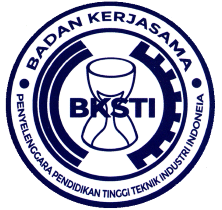Sintesa dan Karakterisasi Bioplastik Dari Tandan Kosong Kelapa Sawit Dengan Modifikasi Penambahan Plasticizer Gliserol dan Sorbitol
DOI:
https://doi.org/10.52759/reactor.v6i1.168Keywords:
Bioplastic, Characterization, Microfibrillated, Cellulose, PlasticizerAbstract
Plastic waste is a global environmental issue due to its non-biodegradable nature. One potential solution is the development of eco-friendly bioplastics derived from natural materials. This study aims to develop bioplastics based on sago starch with the addition of microfibrillated cellulose (MFC) from empty palm oil fruit bunches as a reinforcing filler to enhance mechanical properties. Additionally, plasticizers such as glycerol and sorbitol were added to improve the elasticity of the bioplastic. The plasticizer concentrations used were 1, 5, 10, 20, and 30% w/w. Characterization was conducted through mechanical property tests (tensile strength, elastic modulus, and elongation percentage), morphological analysis using SEM, and structural analysis with Fourier Transform Infrared Spectroscopy (FTIR spectroscopy). The results showed that the addition of 5% glycerol produced a tensile strength of 26.39 MPa with an elongation of 1.2%, while 20% sorbitol yielded a tensile strength of 25.35 MPa with an elongation of 6.2%. Based on the Indonesian National Standard (SNI) for plastics, the combination of sago starch and MFC with 20% sorbitol provided the best mechanical properties, with a tensile strength of 25.35 MPa and an elongation percentage of 5.6%. In conclusion, sago starch-based bioplastic with MFC from oil palm empty fruit bunches has the potential to serve as an environmentally friendly alternative to synthetic plastics
References
A. I. Pratiwi, N. R. Ariyani, C. K. Sari, and A. Rahman, “The Effectiveness of Using Eco- Friendly Bag to Support Sustainable Development Goals: A Review,” J. Presipitasi Media Komun. dan Pengemb. Tek. Lingkung., vol. 21, no. 1, pp. 1–11, 2024, doi: 10.14710/presipitasi.v21i1.1-11.
J. R. Jambeck et al., “Plastic waste inputs from land into the ocean,” Science (80-. )., vol. 347, no. 6223, pp. 768–771, 2015, doi: 10.1126/science.1260352.
K. Wijayanti, Bio-degradeable Bioplastics sebagai Plastik Ramah Lingkungan. SOIJST Vol. 1 (1):131-153. 2018. doi: 10.31219/osf.io/ae6hk.
A. Jerez, P. Partal, I. Martínez, C. Gallegos, and A. Guerrero, “Protein-based bioplastics: Effect of thermo-mechanical processing,” Rheol. Acta, vol. 46, no. 5, pp. 711–720, 2007, doi: 10.1007/s00397-007-0165-z.
E. Kamsiati, H. Herawati, and E. Y. Purwani, “POTENSI PENGEMBANGAN PLASTIK BIODEGRADABLE BERBASIS PATI SAGU DAN UBIKAYU DI INDONESIA / The Development Potential of Sago and Cassava Starch-Based Biodegradable Plastic in Indonesia,” J. Penelit. dan Pengemb. Pertan., vol. 36, no. 2, p. 67, 2017, doi: 10.21082/jp3.v36n2.2017.p67-76.
S. Silviana and P. Rahayu, “Pembuatan Bioplastik Berbahan Pati Sagu dengan Penguat Mikrofibril Selulosa Bambu Terdispersi KCl Melalui Proses Sonikasi,” pp. 151–156, 2017.
D. F. Nury, M. Z. Luthfi, and M. P. Ramadhan, “Optimization of the drying process of edible film-based cassava starch using response surface methodology,” BIO Web Conf., vol. 77, 2023, doi: 10.1051/bioconf/20237701005.
S. Elfina, N. Jamarun, S. Arief, and A. Djamaan, “Sintesis Precipitate Calsium Carbonat Sebagai Filler Pada Plastik Ramah Lingkungan,” React. J. Res. Chem. Eng., vol. 1, no. 1, p. 1, 2020, doi: 10.52759/reactor.v1i1.4.
I. D. G. A. Wiradipta, “Pembuatan Plastik Biodegradable Berbahan Dasar Selulosa Dari Tongkol Jagung,” Dep. Phys. Fac. Math. Nat. Sci. Tenth Nop. Technol. Inst., p. 90, 2017.
I. Nafianto, “Pembuatan Plastik Biodegradable dari Limbah Bonggol Pisang Kepok dengan Plasticizer Gliserol dari Minyak Jelantah dan Komposit Kitosan dari Limbah Cangkang Bekicot (Achatina fullica),” Integr. Lab J., vol. 7, no. 1, pp. 75–89, 2019.
Rahmatullah, R. W. Putri, M. Rendana, U. Waluyo, and T. Andrianto, “Effect of Plasticizer and Concentration on Characteristics of Bioplastic Based on Cellulose Acetate from Kapok (Ceiba pentandra) Fiber,” Sci. Technol. Indones., vol. 7, no. 1, pp. 73–83, 2022, doi: 10.26554/sti.2022.7.1.73-83.
D. F. Nury, A. H. Maulana, I. T. A. Wicaksana, and J. R. H. Panjaitan, “Potensi Kulit Pisang Kepok sebagai Biodegradable Plastic: Pengaruh Konsentrasi Plasticiser terhadap Yield Ekstrak Kulit Pisang,” JoASCE (Journal Appl. Sci. Chem. Eng., vol. 2, no. 2, pp. 1–7, 2024.
C. Andahera, I. Sholikhah, D. A. Islamiati, and M. D. Pusfitasari, “Pengaruh Penambahan Jenis Dan Konsentrasi Plasticizer Terhadap Kualitas Bioplastik Berbasis Selulosa Dari Tandan Kosong Kelapa Sawit,” Indones. J. Pure Appl. Chem., vol. 2, no. 2, p. 46, 2019, doi: 10.26418/indonesian.v2i2.36901.
F. Xie, E. Pollet, P. J. Halley, and L. Avérous, “Starch-based nano-biocomposites,” Prog. Polym. Sci., vol. 38, no. 10–11, pp. 1590–1628, 2013, doi: 10.1016/j.progpolymsci.2013.05.002.
M. M, A. K, S. MI, and I. RA, “Eco-friendly bioprocessing oil palm empty fruit bunch (OPEFB) fibers into nanocrystalline cellulose (NCC) using white-rot fungi (Tremetes Versicolor) and cellulase enzyme (Trichoderma Reesei),” J Fibers Polym Compos, vol. 1, no. 2, pp. 148–163, 2022.
P. Rahayu, M. Z. Luthfi, F. Ikhsandy, and A. K. Yahya, “Penambahan agen pendispersi terhadap morfologi , sifat mekanik , dan biodegradabilitas bioplastik pati sagu dengan penguat selulosa mikro fiber tandan kosong sawit,” pp. 21–30, 2023.
F. Cipta Ismaya, N. H. Fithriyah, and T. Y. Hendrawati, “Pembuatan Dan Karakterisasi Edible Film Dari Nata De Coco Dan Gliserol,” J. Teknol., vol. 13, no. 1, p. 81, 2021.
Isroi, A. Cifriadi, T. Panji, N. A. Wibowo, and K. Syamsu, “Bioplastic production from cellulose of oil palm empty fruit bunch,” IOP Conf. Ser. Earth Environ. Sci., vol. 65, no. 1, 2017, doi: 10.1088/1755-1315/65/1/012011.
A. D. Putra, V. S. Johan, and R. Efendi, “Pembuatan Edible Film Pati Sukun,” Jom Fak. Pertan., vol. 4, no. 2, pp. 1–15, 2017.
L. K. Unsa and G. A. Paramastri, “Kajian Jenis Plasticizer Campuran Gliserol dan Sorbitol Terhadap Sintesis dan Karakterisasi Edible Film Pati Bonggol Pisang Sebagai Pengemas Buah Apel,” J. Kompetensi Tek., vol. 10, no. 1, pp. 35– 47, 2018.
D. P. Rahayu and E. Nurhayati, “Pemanfaatan Activated Spent Bleaching Earth sebagai Adsorben untuk Menyisihkan Rhodamine-B: Studi Adsorpsi Secara Batch,” Envirotek J. Ilm. Tek. Lingkung., vol. 15, no. 1, pp. 91–97175, 2023.
Dian Purwitasari Dewanti, “Potensi Selulosa dari Limbah Tandan Kosong Kelapa Sawit untuk Bahan Baku Bioplastik Ramah Lingkungan,” J. Teknol. Lingkung., vol. 19, no. 1, 2018.
S. D. Hardiningtyas, D. Winarsih, and B. Ibahim, “Efek Penambahan Sorbitol terhadap Karakteristik Film Bioplastik Berbasis Kitosan dan Agar,” J. Pascapanen dan Bioteknol. Kelaut. dan Perikan., vol. 19, no. 1, p. 17, 2024, doi: 10.15578/jpbkp.v19i1.949.
W. T. Wulandari, A. Rochliadi, and I. M. Arcana, “Nanocellulose prepared by acid hydrolysis of isolated cellulose from sugarcane bagasse,” IOP Conf. Ser. Mater. Sci. Eng., vol. 107, no. 1, 2016, doi: 10.1088/1757-899X/107/1/012045.




